Big 3 Newsletter #5: Roger Federer's Serve Breakdown
In this newsletter, we’ll take a look at Roger Federer’s serve, breaking down the Swiss’ calling card shot.
Federer’s serve isn’t the fastest of all time, but it has proven to be a bastion of consistency, variety and supreme placement.
Grip
Federer utilizes a continental grip for his serve.
Equating this grip with the bevels of the racket, this places the knuckle of his index finger on the second bevel.
The first picture below clearly shows Federer using a continental grip.
Basic Steps
Ready Position
Body Sideways to the Target
Left Foot Slightly Less than Sideways
Right Foot Parallel to the Baseline and to the Left of the Left Foot (as opposed to directly behind)
Arms Low and Relaxed
Palm Down/Strings Down
Racket Face Toward the Ground
Points Racket at Back Fence
Racket Over the Head
Racket Moves Over Head
Beginning of Circular Throwing Motion
Racket on Edge
Racket in Supinated Position (palm is turned inwards towards body)
Edge of Racket Faces Ball
Left Arm Tucks in Against Body (occurs as racket passes over head)
Contact
Strings Forward at Contact
Body 45 Degrees Relative to the Net
Pronation
Forearm and Racket Rotate Outward 180 Degrees
Strings Face to Opposite Side of Court
Head Stays Up (promotes swinging up and a consistent contact point/swing path)
Follow Through
Body Balanced
Toss and Swing Out in Front Carries Federer into the Court
Technical Specifics
Power Sources
Body Coil
At the beginning of his serve, Federer coils his body away from the net, activating the kinetic chain. The rotation of Federer’s body throughout the process of the serve occurs in six links:
Foot to Knee
Knee to Hip
Hip to Shoulder
Shoulder to Elbow
Elbow to Forearm
Forearm to Hand
Creating this linkage system in a smooth, continuous manner is one of the reasons Federer’s serve appears so fluid, yet delivers such a power punch.
360 Degrees of Racket Rotation
When Federer brings his racket in over his head, he is doing so in order to maximize the amount of racket rotation. Federer is able to create a strong, circular (360 degrees) throwing motion over his head by making this move. Players that do not do this, such as Kei Nishikori, are not able to maximize the amount of racket head speed they generate on their serves because they do no establish a complete throwing motion.
Pronation
The third major power source to explore here is pronation. Pronation is the outward rotation of the forearm, which presents the strings to the hit from an on edge position. Imagine throwing a ball. You’ll maximize how fast you can throw the ball by turning your forearm inside out. The same concept applies on a serve. The outward rotation of the forearm is the fastest way for Federer to move his racket through the hit. Combining the 360 degrees of rotation prior to being on edge with 180 degrees of rotation from the on edge position through the completion of the hit allows Federer to generate effortless pace.
Glass of Water Ball Toss
A common issue among recreational tennis players around the world is an inconsistent ball toss. Most recreational players hold the ball with their palm facing the sky. As a result, their hand, elbow and shoulder are all playing a part in the ball moving up and out of the hand.
Federer, by contrast, isolates his shoulder by holding the ball as if he were holding a glass of water. Isolating the shoulder provides for a more consistent toss as the entire arm moves as one unit, rather than three separate units at once.
Toss Timing
When Federer releases the ball, as can also be seen in the previous picture, his racket has lifted into a closed position, prior to the racket coming in over his head. His tossing arm will begin lifting as the racket is moving back across his feet and the release will occur as the racket is lifting.
Federer’s toss release point is crucial to creating a rhythmic swing. If Federer were to toss the ball earlier in his swing, he would have to toss high to compensate for needing more distance for the racket to travel. If Federer were to toss the ball with the racket above the tossing arm at the toss release point, he would have to toss low as the racket would be too close to the desired contact point.
Federer’s fluid, continuous swing creates effortless power and allows him to execute at a high level in pressure situations.
Left Arm Reactive Brake
A common belief for players learning how to serve is that the left arm (right arm for lefties) should pull the body to and through the hit. Federer demonstrates that the opposite is true.
After Federer tosses the ball and as the racket passes over his head, his left arm stretches out toward the court and tucks in against his body. By doing this, Federer slows down the left side of his body, which was rotating forward. The energy from the left side of his body is then transferred to the right side of his body and his hitting arm. Yet another power mechanism that Federer integrates on his serve.
Flat/Sidespin Serve vs. Topspin Serve
Federer hits three types of serves: flat, sidespin and topspin.
There are three key differences between Federer’s flat/sidespin serve and his topspin serve:
Contact Point
Federer’s contact point for his topspin serve is to the inside of his hand, which you can see on the left in the picture below. This is a natural result of the low to high brushing motion that must occur to hit a topspin serve. The contact point for a flat or sidespin serve is typically far more aligned with the hitting hand, which you can see on the right in the picture below.
Body Positioning
Federer’s topspin serve requires him to increase the upward angle of his swing, in order to brush low to high up the back of the ball to produce topspin. Because Federer is seeking a more vertical swing path on a topspin serve, his body remains more sideways to the net which allows him to swing up more. If Federer were to open his body, he would find it tougher to obtain the necessary upward swing needed to produce a lethal topspin serve.
Racket Face Angle
When hitting a topspin serve, Federer’s racket face is more severely closed prior to his upward ascension to the contact point, as can been seen below on the picture to the left. Federer is looking to increase the upward angle of his swing on this shot. Closing off the racket face prior to the upward ascension to contact helps facilitate the increase in the upward angle of the swing.












